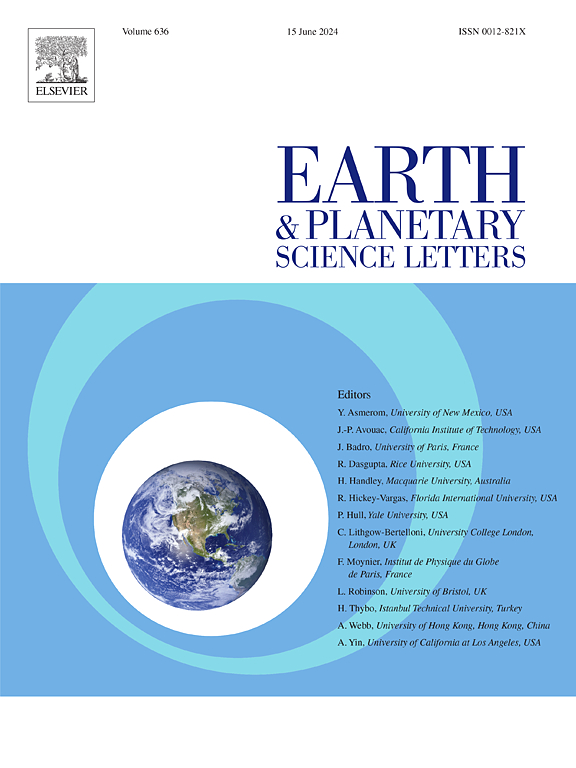利用气候模型预测沙丘迁移和沙丘地形对气流的加速效应
IF 4.8
1区 地球科学
Q1 GEOCHEMISTRY & GEOPHYSICS
引用次数: 0
摘要
本研究提出并验证了一种工作流程,该流程可将遥感测量到的沙丘迁移速度与气象站测量到的或从再分析数据中提取的风速定量联系起来。该工作流程要求选择沙粒迁移规律,并估算当地地形对近地面气流的影响,即风力沿沙丘地形上升时压缩流线所产生的加速效应。此外,对自然条件下沙流量的估算还需要考虑短时阵风的影响,而气候模型通常不会充分考虑或采样短时阵风。由于风沙传输模型的非线性,这些风速的时空变化对当地的风沙通量有很大影响。我们通过计算流体动力学(CFD)模型来估算气流和输沙的加速效应,从而研究这些影响。接下来,我们在阿拉伯湾南缘的两个沙漠巴坎沙丘区,将这种效应纳入预测的沙丘迁移率与遥感观测结果进行比较。我们发现,在这两个地点,加速效应使预测的沙通量增加了 ∼ 3 倍,如果使用 Kok 等人(2012 年)的沙迁移规律,结合 Pähtz 和 Durán(2023 年)的停止阈值以及每小时采样的再分析数据 ERA5-Land,则测量和预测的沙丘迁移率非常吻合。建议的工作流程适用于地球或火星上的任何沙丘地。本文章由计算机程序翻译,如有差异,请以英文原文为准。
Prediction of barchan dunes migration using climatic models and speed-up effect of dune topography on air flow
This study presents and validates a workflow that quantitatively links the rate of barchan dunes migration, which can be measured from remote sensing, to the wind velocity, either measured at a meteorological station or extracted from reanalysis data. The workflow requires the selection of a sand transport law and a procedure to estimate the effect of the local topography on the near surface airflow, namely the speed-up effect, that results from the compression of streamlines as the wind climbs up the dune topography. Additionally, the estimate of sand flux under natural conditions needs to account for short duration wind gusts which are usually not fully accounted for or sampled in climatic models. Those spatial and temporal variations of wind speed have a strong influence on the local sand flux due to the non-linearity of the sand transport models. We investigate these effects by using computational fluid dynamic (CFD) modeling to estimate the speed-up effect on airflow and sand transport. We next include that effect to compare the predicted dune migration rate with remote sensing observations, at two desert barchan dune fields located along the southern rim of the Arabia Gulf. We find that, at the two sites, the speed-up effect increases the predicted sand flux by a factor of ∼3 and that the measured and predicted dune migration rates agree well if the sand transport law of Kok et al. (2012) is used, combined with the cessation threshold from Pähtz and Durán (2023) along with reanalysis data ERA5-Land with an hourly sampling. The proposed workflow is applicable to any barchan dune field on Earth or Mars.
求助全文
通过发布文献求助,成功后即可免费获取论文全文。
去求助
来源期刊

Earth and Planetary Science Letters
地学-地球化学与地球物理
CiteScore
10.30
自引率
5.70%
发文量
475
审稿时长
2.8 months
期刊介绍:
Earth and Planetary Science Letters (EPSL) is a leading journal for researchers across the entire Earth and planetary sciences community. It publishes concise, exciting, high-impact articles ("Letters") of broad interest. Its focus is on physical and chemical processes, the evolution and general properties of the Earth and planets - from their deep interiors to their atmospheres. EPSL also includes a Frontiers section, featuring invited high-profile synthesis articles by leading experts on timely topics to bring cutting-edge research to the wider community.
 求助内容:
求助内容: 应助结果提醒方式:
应助结果提醒方式:


